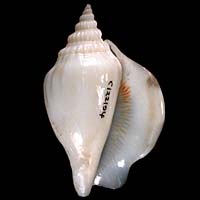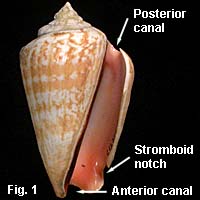|
< Previous family introduction |
|
|||||
 |
Family Strombidae Strombs
|
|||||
|
The Strombidae is a small family of medium to large size shells that includes the strombs with a flared lip in genus Strombus, the spider shells in the genus Lambis, shells with a very long anterior canal in Tibia, and a single species of Terebellum. The largest species in the family is Strombus goliath from Brazil that reaches 375 mm, but Lambis truncata which is found in the Indo-West Pacific, including Queensland, reaches 350 mm. There is about 72 species in the family, of which about 36 occur in tropical Australia. Strombs are predominately tropical and subtropical, well represented in the Indo-West Pacific region which includes northern Australia. They are intertidal and shallow subtidal animals that feed on macroalgae and epiphytes on sandy or slightly muddy substrates. Sexes are separate, with internal fertilisation. After fertilisation, the female deposits eggs in long thin gelatinous strings that hatch as planktonic larvae. After 2-3 weeks in the plankton, larvae settle out and begin to grow to adults. Two features of strombid organisation are notable. The first is the effective and prominent eyes on stalks. The right stalk extends through a notch, termed the stromboid notch, in the outer lip of the shell, and the left stalk extends through the anterior canal. The second feature is the method of locomotion. In most gastropods, the animal slides along the substrate on a mucous-lubricated path by waves of contraction in the foot. In strombs, the serrated, pointed operculum on the end of the foot is dug into the substrate and the animal pulls itself forward in a series of leaps with the operculum as an anchor. The species which are found in NSW have centres of distribution in the tropical Indo-West Pacific, and NSW is at the southern limit of their range. There are six species recorded from the state, with southernmost records varying from Clarence River in the north of the state to Shellharbour south of Sydney. Only one species, Strombus luhuanus, has established breeding populations as far south as Sydney. In addition to the six extant species, five others were obtained as fossil shells from dredging in Sydney Harbour in the 1930s. These five are common in the tropics, but not known from modern shells in NSW. Family References Abbott, R. T. 1960. The genus Strombus in the Indo-Pacific. Indo-Pacific Mollusca, 1(2): 33-146, pls. 11-117. Abbott, R. T. 1961. The genus Lambis in the Indo-Pacific. Indo-Pacific Mollusca, 1(3): 147-174, pls. 118-134. Kreipl, K. & Poppe, G.T. 1999. A Conchological Iconography. The Family Strombidae. ConchBooks: Hackenheim, Germany. Walls, J. G. 1980. Conchs, Tibias and Harps. TFH Publications: New Jersey. 191 pp. Coverage In addition to the species illustrated, the following are known from NSW: Strombus erythrinus Dillwyn, 1817 Indo-West Pacific. In Australia, from Torres Strait to Moreton Bay, Queensland. In NSW, one fossil specimen from Sydney Harbour, from dredge Triton. Strombus labiatus (Röding, 1798) Indo-West Pacific. In Australia, from Darwin, NT, to Moreton Bay, Queensland. In NSW, one fossil shell from Sydney Harbour, from dredge Triton. This was named Canarium otiolum Iredale, 1931. Strombus plicatus (Röding, 1798) Indo-West Pacific. In Australia, from North West Shelf, WA, to Fraser Island, Queensland. In NSW, one fossil specimen from Sydney Harbour, from dredge Triton, recorded by Iredale and McMichael (1962) as Conomurex pulchella (Reeve, 1851). Strombus vittatus Linnaeus, 1758 Indo-West Pacific. In Australia, from Shark Bay, WA, to Moreton Bay, Queensland. In NSW, one fossil specimen from Sydney Harbour, from dredge Triton. Strombus vomer (Röding, 1798) Indo-West Pacific. In Australia, from Fremantle, WA, to Northern Territory, and Queensland. In NSW, one lot of fossil shells from Sydney Harbour, from dredge Triton. These were named Euprotomus donnellyi Iredale, 1931. Identification Notes In this family the distinctive adult shell characters develop only when the shell is fully grown.. The expanded outer lip, columella callus, aperture colouration and inner and outer lip sculpture all develop with maturity, giving adults quite a different appearance to juveniles. (See Strombus luhuanus for figure). One of these adult features is the "stromboid notch" (Fig. 1), a wide notch on the anterior part of the outer lip; it provides an opening for the right eye on its long stalk. |
|||||
 |